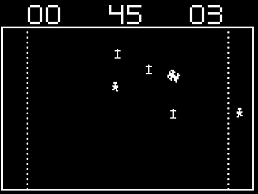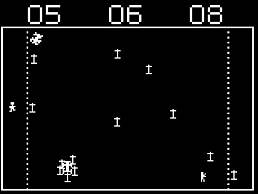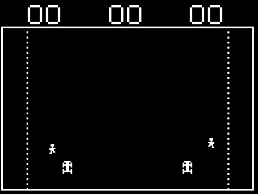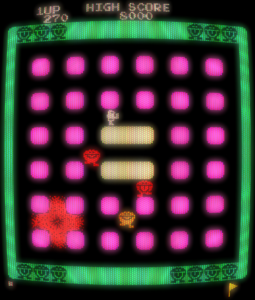 The Game: Two players control one car each, careening freely around an arena filled with zombies. Faced with zombie-fication at the pedestrian crossing of the undead, the drivers have only one option: run over their opponents! Each zombie that’s squashed leaves a grave marker behind that becomes an unmovable obstacle to zombies and cars alike. Whoever has run over the most zombies by the end of the timed game wins. (Exidy, 1976)
The Game: Two players control one car each, careening freely around an arena filled with zombies. Faced with zombie-fication at the pedestrian crossing of the undead, the drivers have only one option: run over their opponents! Each zombie that’s squashed leaves a grave marker behind that becomes an unmovable obstacle to zombies and cars alike. Whoever has run over the most zombies by the end of the timed game wins. (Exidy, 1976)
Memories: Death Race, which didn’t even come within shouting distance of having anything to do with the movie of the same name, was the arcade game that sparked the very first protests about violence in video games. Those protests go on to this very day, with games like the latest iteration of Grand Theft Auto and Bully drawing fire for depicting various kinds of real world violence. Compared to those much more recent games, it’s almost laughable to think that the abstraction of Death Race was where some parents first drew the line. Why? Because Death Race was the first person to put stick figures – a representation of a human being – on the screen and let you do something nasty to them.
Of course, Exidy responded to the criticisms and protests by pointing out that the game lets you run over zombies, not people. Not that primitive pixellated stick figures really spell that out for anyone, mind you, but one wonders what the protest was really about: was Death Race any more or less cruel than the old non-electronic favorite, Whack-a-Mole? Where were these complaints when Operation made a game out of medical malpractice? Come on – if you’re going to decide to be offended by something, you can’t just cherry-pick what offends and doesn’t offend you. Presumably these are the same protestors who went on to have dodgeball removed from public schools.


Exidy was raked over the coals in venues such as Phil Donahue’s talk show, but the new company – headed up by Pete Kaufman, late of Ramtek – thrived on the notoriety, even though it’s widely believed that the production run of Death Race was halted at only 500 or so machines. Atari‘s Nolan Bushnell thrived on the opportunity for grandstanding that the protests gave him, proclaiming to the public that no Atari game would ever depict violence against human beings. (For what it’s worth, this promise was kept until the end of the “Bushnell administration” at Atari, after which he was no longer making decisions about game content.)
As a game, Death Race is nothing more than a demolition derby with pedestrians. The graphics and sound are primitive to say the least, but a mere four years after Pong and the Odyssey, they’re not a bad step up – especially when it was still common at the time to utilize decidedly non-computer-generated artwork mirrored onto the screen, or placed over the screen (a la Night Driver), to create the illusion of more  advanced graphics. None of these things, however, mean that it wasn’t fun – and it certainly started a movement that continues to this day, with other game makers taking up the baton and pushing the envelope of game violence even further into realism. Exidy itself came under fire again later for a light gun coin-op horror game called Chiller, but by then the graphics technology existed to at least create strongly impressionistic images of violence; to think that the never-ending debate over video game violence started with stick figures is almost laughable.
advanced graphics. None of these things, however, mean that it wasn’t fun – and it certainly started a movement that continues to this day, with other game makers taking up the baton and pushing the envelope of game violence even further into realism. Exidy itself came under fire again later for a light gun coin-op horror game called Chiller, but by then the graphics technology existed to at least create strongly impressionistic images of violence; to think that the never-ending debate over video game violence started with stick figures is almost laughable.

